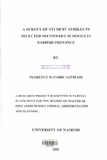| dc.description.abstract | The main purpose of this study was to investigate the underlying causes of student strikes in selected secondary schools in Nairobi Province. It also sought to establish some possible ways of curbing these student strikes. The study also highlighted some of the effects of these student strikes as well as giving some policy recommendations which, if implemented would go a long way in curbing these strikes.
The study attempted to answer research questions touching on areas such as: some of the major causes of student strikes in secondary schools, the part that guidance and counselling would play in curbing student strikes in secondary schools; the attitude of the headteachers on the rising cases of student strikes in the schools, the suggestions given by the headteachers for curbing the rising cases of student strikes and the effects of the student strikes on the schools.
The study was organized in five main chapters. The first chapter presents the introduction of the study which comprises the background to the problem, statement of the research problem, purpose of the study, objectives of the study, research questions, significance of the study, delimitations of the study, limitations of the study and definition of significant terms.
The second chapter comprises the literature review which was organized under various sub - headings. These were:- school administration and discipline; some causes of indiscipline in secondary schools; school administration and the role played by the headteachers; the authoritarian structure of the school; guidance and counselling services; inadequate facilities in schools; the nature of the school curriculum; social factors; mixed daylboarding schools; drug abuse; headteachers' attitude towards student indiscipline and conclusion.
The third chapter comprises the research methodology which includes the research design, the target population, the area of study, research instruments and sampling procedures, validity of the instruments, reliability of the instruments, data collection procedure and data analysis technique. The study used a survey method with an application of ex post facto research design on 35 secondary schools. From the schools, 35 headteachers and 35 deputy headteachers participated in this study. Two types of research instruments were used to elicit data. These were, questionnaires for the deputy headteachers and headteachers and interview schedule for the headteachers. The study used objectives and research qt;_estions which guided the research.
The fourth chapter comprises data analysis and results. Tables showing frequencies and percentages were used to present the collected data. Data
analvsis results were then interoreted accordingly and conclusions drawn. The nnn and fast chapter comprises the summary or the study nndmgs, the conclusion. recommendations and suggestions for further research.
From the study findings. the researcher established that student strikes in secondary schools and in particular. in secondary schools in Nairobi Province is a living reality. Top on the list of causes of these strikes was blamed on the school administration for failure to establish effective means of communication between themselves (the administrators) and the
students as well as the teachers. In many cases. headteachers are dictatorial using decrees to run schools while students are supposed to be passive recipients of these decrees. This. in many ways acted as an obstacle in the solution of conflicts that lead to student strikes. Drug abuse and addiction is also a common problem in both day and boarding schools - mainly in boys schools. Most schools are situated in estates (residential areas) making drugs readily available for students. A number of student strikes are attributed to drug abuse.
Lack of effective guidance and counselling services in schools is also singled out as a major cause of student strikes. These services are usually given at cnsis times SInce the teachers are too busy trying to cover the syllabuses leaving little time for them. Other maior causes of student strikes
include: poor parenting, lack of essential facilities III schools, bad/poorly cooked food, political interference, among others.
Some suggestions and recommendations are given at the end of chapter five which may work towards reducing the incidents of student strikes III secondary schools. Among these is the need to improve on lines of communication between the school administration and the students as well as the teachers; the need to strengthen the guidance and counselling departments and to improve on provision of these services; need for the Ministry of Education, Science and Technology to appoint competent school managers among many others.
Suggestions for further research on this area of student strikes are also given. Among these is the need to have a case study of a school with frequent cases of student strikes and also a study on the relationship between students' academic performance and students' deviant behaviour. | en |

